Let’s be honest: in 2025, running a food business without data is like trying to make pizza without dough. The food delivery world is now a $840+ billion global market, and it’s only getting hungrier for data every year (). I’ve watched restaurants, delivery platforms, and food brands scramble to keep up with ever-shifting menus, prices, and customer reviews. It’s a wild ride—one minute you’re the top burger joint in your city, the next you’re losing orders to a competitor who just dropped their delivery fee by a buck.
That’s why food data scraping services have become the not-so-secret sauce for staying competitive. Whether you’re a sales lead, an ops manager, or just someone who wants to know why the vegan wraps are always sold out, scraping food delivery data is now mission-critical. In this post, I’ll walk you through the top 10 food data scraping services for 2025, compare their features, and show you how to pick the right one for your business—plus, I’ll give you a peek at how (my team’s pride and joy) can help you scrape Uber Eats data in just two clicks. Grab a snack, because we’re about to dig in.
Why Food Data Scraping Services Matter for Modern Food Businesses
Food data scraping services are specialized tools that automatically gather information from food delivery platforms, restaurant websites, and online menus, then serve it up in a structured format for analysis. In 2025, these services aren’t just “nice to have”—they’re essential for anyone in the food industry who wants to keep up with the pace of change.
Here’s why:
- Competitor Price Tracking: The battle for customer loyalty is fierce. If your rival drops the price of their signature burger, you need to know—fast. Food data scraping lets you monitor competitor prices on platforms like Uber Eats, DoorDash, or Deliveroo in real time ().
- Menu Monitoring: Menus change constantly. Scraping services can list every item your competitors sell, spot new additions, and help you identify trending dishes before you’re left behind ().
- Customer Sentiment: Scraping reviews and ratings gives you a pulse on what customers love (or hate). This is gold for improving your own offerings and marketing.
- Operational ROI: Real-world cases show that using scraped data can boost average order value by 22% and increase orders by 15% with targeted, data-driven promotions ().
- Time Savings: Manually checking dozens of apps is a full-time job. Scraping automates the grunt work, freeing up your team for strategy.
In short, if you’re not using food data scraping, you’re probably missing out on revenue, efficiency, and a whole lot of competitive intelligence.
Quick Comparison Table: Top 10 Food Data Scraping Services
Before we get into the nitty-gritty, here’s a high-level look at the top 10 food data scraping services for 2025. I’ve compared them on supported platforms, AI features, ease of use, export options, pricing, and what makes each one special.
| Service | Supported Platforms | AI & Automation | Ease of Use | Export Options | Pricing Model | Unique Features |
|---|---|---|---|---|---|---|
| Thunderbit | Any website (Uber Eats, etc.) | AI suggests fields, subpage & pagination automation | Very high (no-code Chrome extension, 2-click scraping) | Google Sheets, Excel/CSV, Airtable, Notion (free exports) | Freemium (free tier, credits for volume) | 2-click scraping, prebuilt templates, subpage scraping |
| FoodDataScrape.com | Major delivery apps (Uber Eats, DoorDash, etc.) | AI/ML data cleaning, managed maintenance | Medium (managed service) | API, custom dashboards, CSV/JSON | Custom enterprise pricing | Custom datasets, massive scale |
| Foodspark | Global food & grocery apps | AI-powered scraping, real-time API, scheduling | Medium (managed service, 24/7 support) | CSV, Excel, XML, API, scheduled reports | Custom pricing | Competitor price monitoring, menu/review scraping |
| Xwiz | Uber Eats, DoorDash, Zomato, etc. | Advanced automation, analytics dashboards | Medium (managed service) | Reports, dashboards, CSV/Excel | Custom pricing | Market insights, trend analysis |
| RealdataAPI | Uber Eats, Zomato, Swiggy, etc. | API-centric, real-time data, customizable fields | For developers (API integration) | JSON via API, CSV/Excel | Pay-as-you-go or subscription | Rich data fields (nutrition, allergens), multi-country |
| Actowiz | Global delivery apps | Scheduling, AI-based data intelligence | Medium (service + dashboards) | API, dashboards, CSV/JSON | Custom | Price intelligence, dynamic pricing |
| Websitescraper | Zomato, Swiggy, Uber Eats, etc. | Food Scraping API, scheduling | High (managed service) | API, downloadable datasets | Custom | User-friendly API, restaurant/grocery/liquor data |
| iWeb Data | Global platforms (Uber Eats, Grubhub, etc.) | Managed crawling, scheduling, multi-format delivery | High (direct support, maintenance) | Email, API, webhooks, FTP, DB import | Custom | Global coverage, localization, fast support |
| Botster | Any website (templates for popular sites) | No-code bot builder, scheduling | Very high (100+ prebuilt bots, easy UI) | Excel/CSV, email, Slack, Google Drive | Freemium (free basic bots, paid for volume) | No-code automation, rich integrations |
| WebData Crawler | Food/quick commerce apps (Instacart, Gopuff, etc.) | Real-time scraping, scalable cloud extraction | Medium (service provider) | API, dashboards, custom feeds | Custom (enterprise focus) | Fast, scalable, real-time updates |
What Can You Scrape with Food Data Scraping Services?
Food data scraping isn’t just about grabbing prices or menu names. The best services can extract a smorgasbord of information, including:
- Restaurant Listings: Names, locations, hours, contact info—great for mapping competitors or building your own directory ().
- Menu Items & Descriptions: Complete menus, categories, and item descriptions. Perfect for menu engineering and spotting trends ().
- Prices & Fees: Item prices, combos, delivery fees, service charges, taxes—essential for dynamic pricing ().
- Promotions: Coupons, deals, and special offers. Your marketing team will thank you ().
- Customer Ratings & Reviews: Star ratings and review text for sentiment analysis and benchmarking ().
- Delivery Time Estimates: Estimated and actual delivery times for operational benchmarking ().
- Order Volume & Popularity: Some services can even track how often dishes are ordered or which restaurants are busiest ().
- Images: Menu item photos, restaurant images, logos—useful for visual analysis or enriching your own listings ().
- Nutritional Info & Ingredients: For health-focused businesses or compliance ().
- Meta-Data: Delivery areas, payment methods, minimum orders, and more ().
All this data supports smarter pricing, sharper market research, and better operational decisions. I’ve seen teams combine scraped price data with review sentiment to launch new menu items that hit the sweet spot—literally and figuratively.
How to Choose the Right Food Data Scraping Service
Picking the right food data scraping service is a bit like choosing a restaurant: it depends on your taste, budget, and what you’re hungry for. Here’s what I recommend considering:
- Supported Platforms: Make sure the service covers the delivery apps or websites you care about—Uber Eats, DoorDash, Zomato, Grubhub, or even niche local platforms ().
- Ease of Use: Are you a non-technical user? Go for no-code tools like Thunderbit or Botster. If you have developers, API-first services like RealdataAPI are great.
- AI Features: AI can make scraping smarter and faster. Thunderbit’s AI suggests fields and even formats data on the fly ().
- Data Accuracy & Freshness: Look for services that emphasize quality and can handle frequent updates or scheduling ().
- Export & Integration: Do you want your data in Excel, Google Sheets, Airtable, or via API? Make sure the service fits your workflow ().
- Compliance: Stick with providers who only scrape public data and respect platform rules ().
- Customer Support: Good support is crucial. Some services offer 24/7 help or direct support for fixing broken scrapers ().
- Scalability & Cost: Estimate your data needs. Thunderbit and Botster are affordable for small jobs; enterprise services like or Actowiz are built for scale.
Pro tip: Start with a free trial or pilot project. Scrape a sample dataset and see if it meets your needs before committing.
Thunderbit: Scrape Food Data from Uber Eats in 2 Clicks
Let’s get hands-on. Thunderbit is an Chrome extension that makes scraping food delivery data as easy as ordering takeout. The whole idea behind Thunderbit is to make web scraping accessible to everyone—no code, no headaches, just results.
Why Thunderbit?
- AI-Powered Simplicity: Thunderbit reads the page, suggests the right fields (like “Restaurant Name,” “Price,” “Rating”), and structures your data automatically.
- Subpage Scraping: Need more details? Thunderbit can visit each restaurant’s page and pull full menus, prices, and more—automatically.
- Pagination Handling: It scrolls and loads more results, so you don’t miss a single restaurant.
- Instant Export: Send your data straight to Google Sheets, Excel, Airtable, or Notion. All exports are free.
- Scheduled Scraping: Set it and forget it—Thunderbit can run scrapes on a schedule (think: “every Monday at 9am”).
- Free Tier: Scrape up to 6 pages for free, or 10 with a trial. After that, it’s a credit system (1 credit = 1 output row).
I’ve seen even the most tech-averse sales folks become data pros with Thunderbit. It’s that easy.
Step-by-Step: Using Thunderbit to Scrape Uber Eats Data
Here’s how you can use Thunderbit to scrape Uber Eats (or any food delivery site) in just a couple of clicks:
- Open Uber Eats: Go to the Uber Eats website and search for restaurants in your area.
- Launch Thunderbit: Click the Thunderbit Chrome extension to open the AI Web Scraper.
- AI Suggest Fields: Hit the “AI Suggest Columns” button. Thunderbit’s AI will scan the page and suggest fields like Restaurant Name, Cuisine, Rating, Delivery Fee, etc. You can tweak these if you want.
- Scrape: Click “Scrape.” Thunderbit will scroll through the results and extract the data into a table.
- Scrape Subpages (Optional): Want full menus? Click “Scrape Subpages” and Thunderbit will visit each restaurant’s page, pulling menu items, prices, and more.
- Export: Choose your export option—Google Sheets, Excel, Airtable, Notion, CSV, or JSON. Done!
You can see more about how this works in the .
Why is this a big deal? Because what used to take hours of copy-pasting or fiddling with code is now a two-click operation. I’ve watched teams go from “we wish we could get this data” to “wow, we have it already?” in minutes.
FoodDataScrape.com: Custom Food Data Extraction for Enterprises
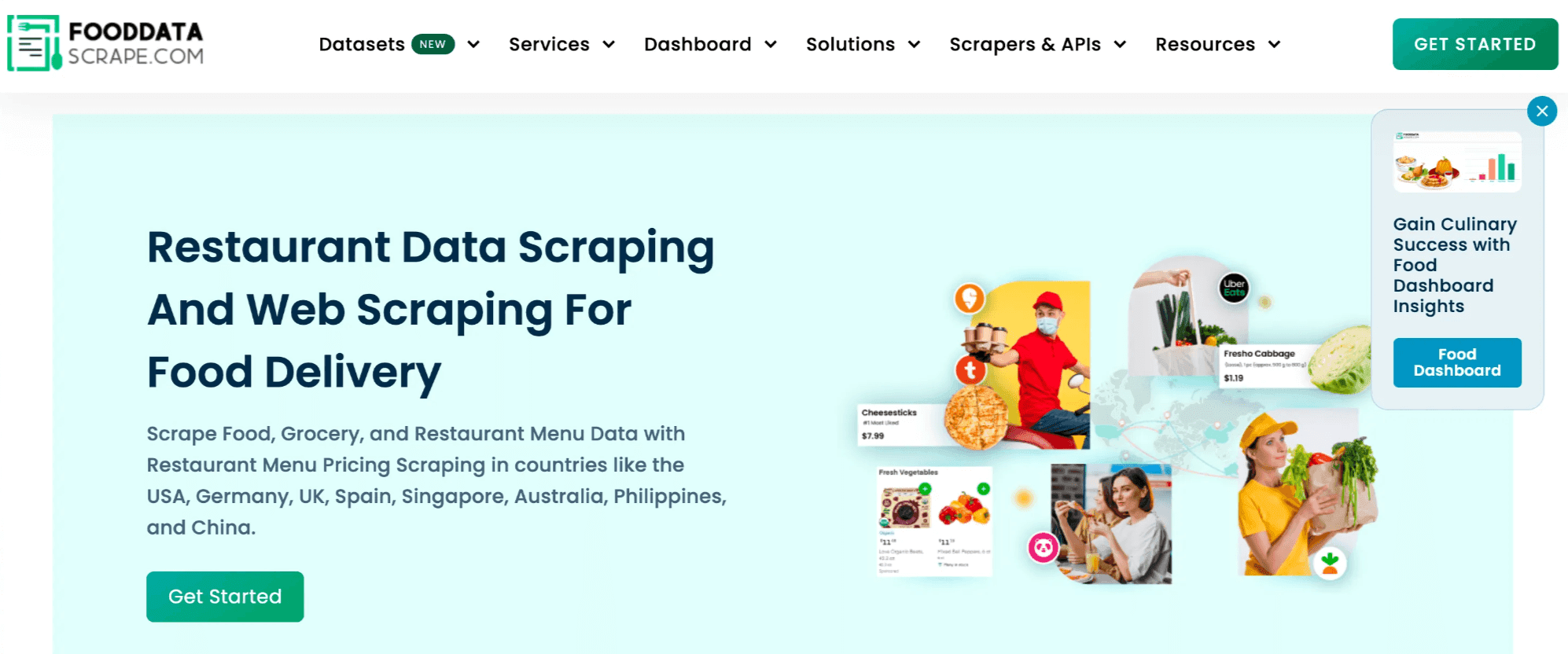
FoodDataScrape.com is all about scale and customization. If you’re a large restaurant chain, aggregator, or market research firm, this managed service can deliver massive, clean datasets from platforms like Uber Eats, DoorDash, Zomato, and more.
- Custom Datasets: Get full datasets for specific platforms, regions, or even historical data.
- AI/ML Data Cleaning: Their system automatically cleans and validates data for accuracy.
- API Access & Dashboards: Integrate data directly or get visual reports.
- Enterprise Focus: Handles millions of pages per day, adapts to site changes, and offers real human support.
Best for: Enterprises that need hands-off, high-volume, or highly customized food data scraping.
Foodspark: Automated Menu and Delivery Data Scraping
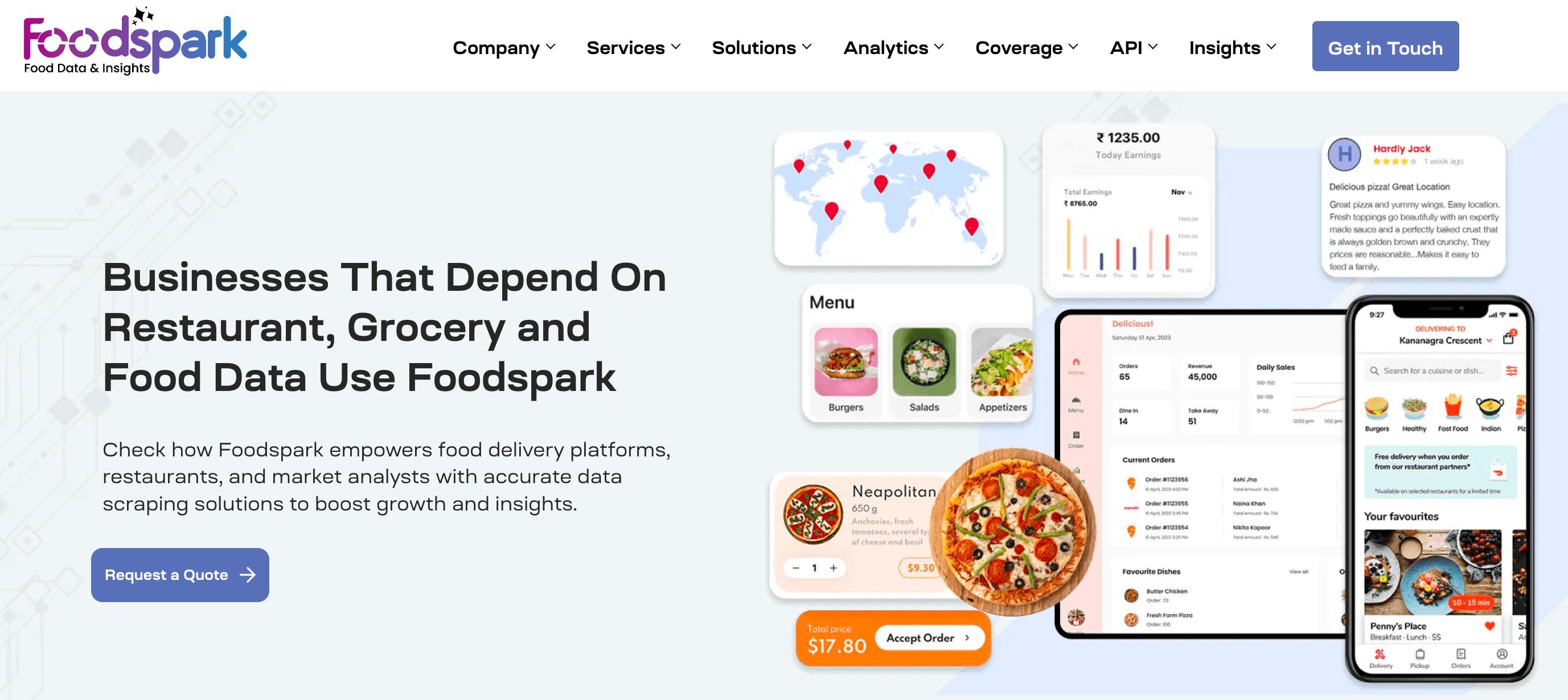
Foodspark is a managed service specializing in menu, pricing, and delivery analytics. They’re a great fit for restaurants and delivery businesses that want to harness food data intelligence without building scrapers in-house.
- Global Coverage: Supports Uber Eats, DoorDash, Deliveroo, Instacart, and more.
- AI-Powered & Real-Time API: Get instant access to scraped data and schedule regular updates.
- Competitor Monitoring: Track prices, promotions, and reviews across platforms.
- 24/7 Support: Their team handles everything, so you can focus on strategy.
Best for: Midsize chains, CPG brands, or anyone needing ongoing competitive analysis.
Xwiz: AI-Powered Food Data Scraping for Market Insights
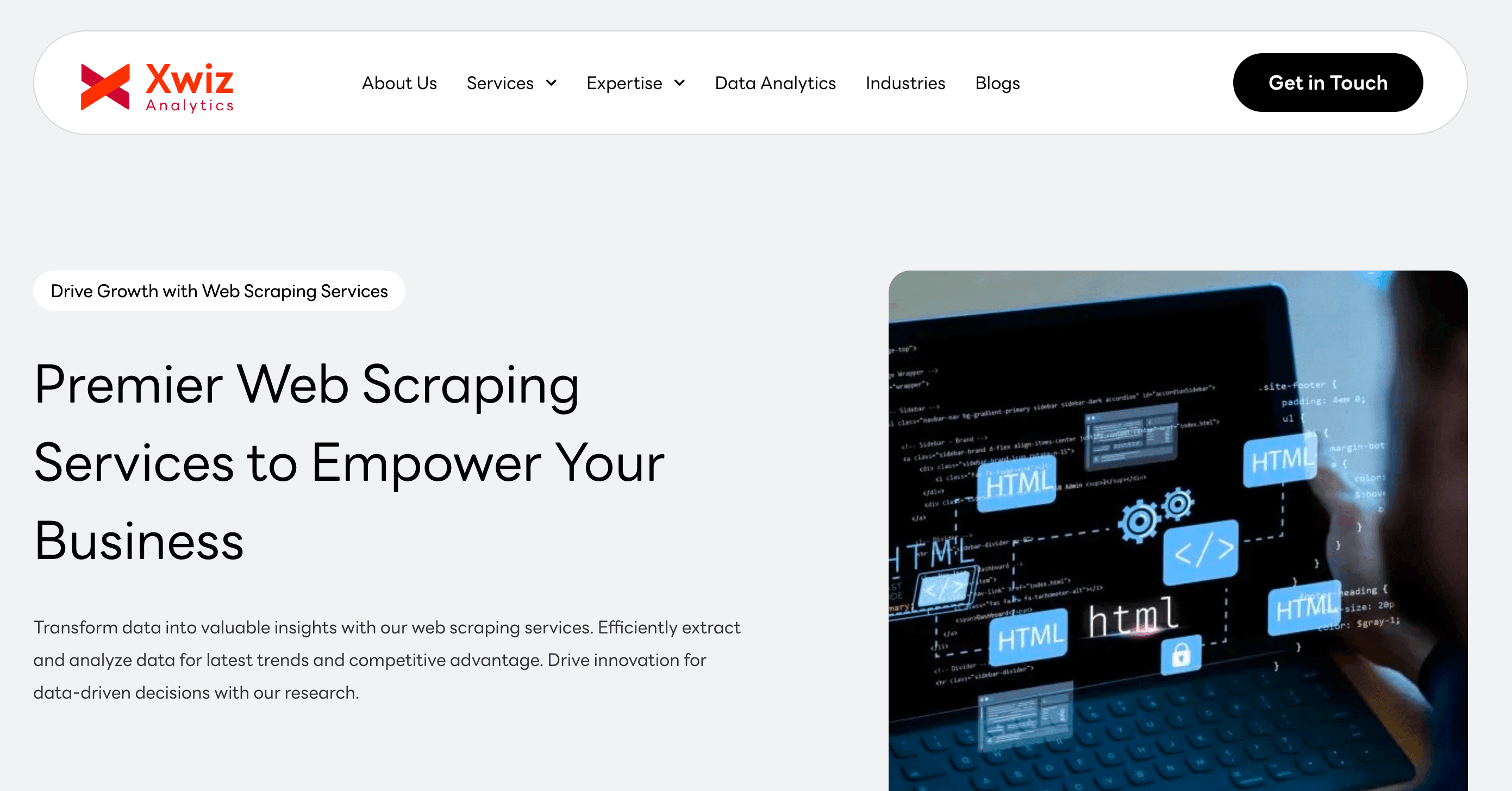
Xwiz brings a blend of scraping and analytics, focusing on market insights and competitor intelligence.
- Comprehensive Data: Restaurant listings, menus, prices, reviews, order volume, delivery metrics.
- Analytics Dashboards: Get reports and trend analysis, not just raw data.
- Custom Projects: Flexible for unique or complex needs.
Best for: Businesses that want actionable insights and market analysis, not just spreadsheets.
RealdataAPI: API-First Food Data Scraping Service
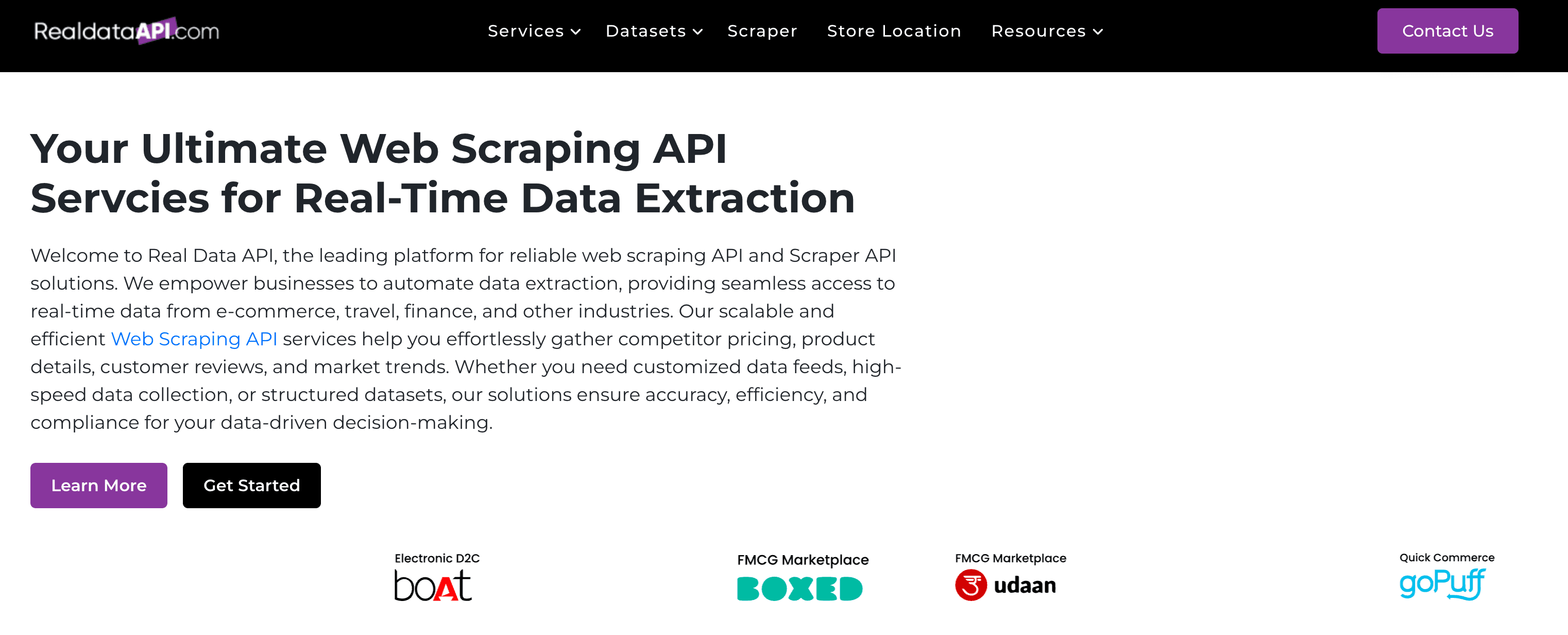
RealdataAPI is built for developers and product teams who want real-time, programmatic access to food data.
- Wide Platform Support: Uber Eats, Zomato, Swiggy, Postmates, and more, across multiple countries.
- Granular Fields: Menus, prices, nutrition, allergens, reviews, and more.
- API-Driven: Pull data on-demand or schedule regular updates.
- Customizable: Specify exactly which fields you want.
Best for: Teams with developer resources who need to integrate food data directly into their apps or analytics pipelines.
Actowiz: Food Delivery Data Scraping for Price Monitoring
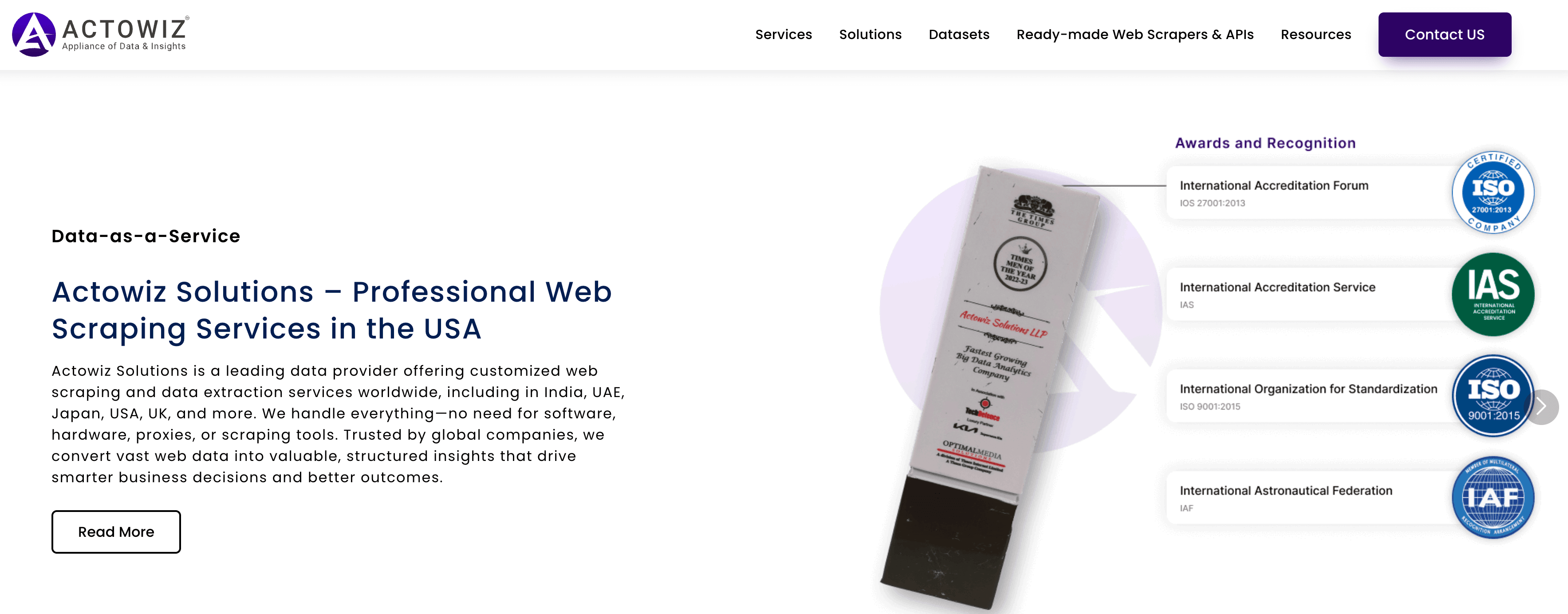
Actowiz is all about price intelligence and competitor tracking.
- Comprehensive Data: Menus, prices, reviews, delivery metrics, and more.
- Dynamic Pricing & Alerts: Get notified when competitors change prices or launch promotions.
- Scheduling & Dashboards: Set up regular scrapes and visualize data in custom dashboards.
Best for: Chains or platforms focused on staying ahead in the pricing game.
Websitescraper: Menu and Restaurant Data Extraction
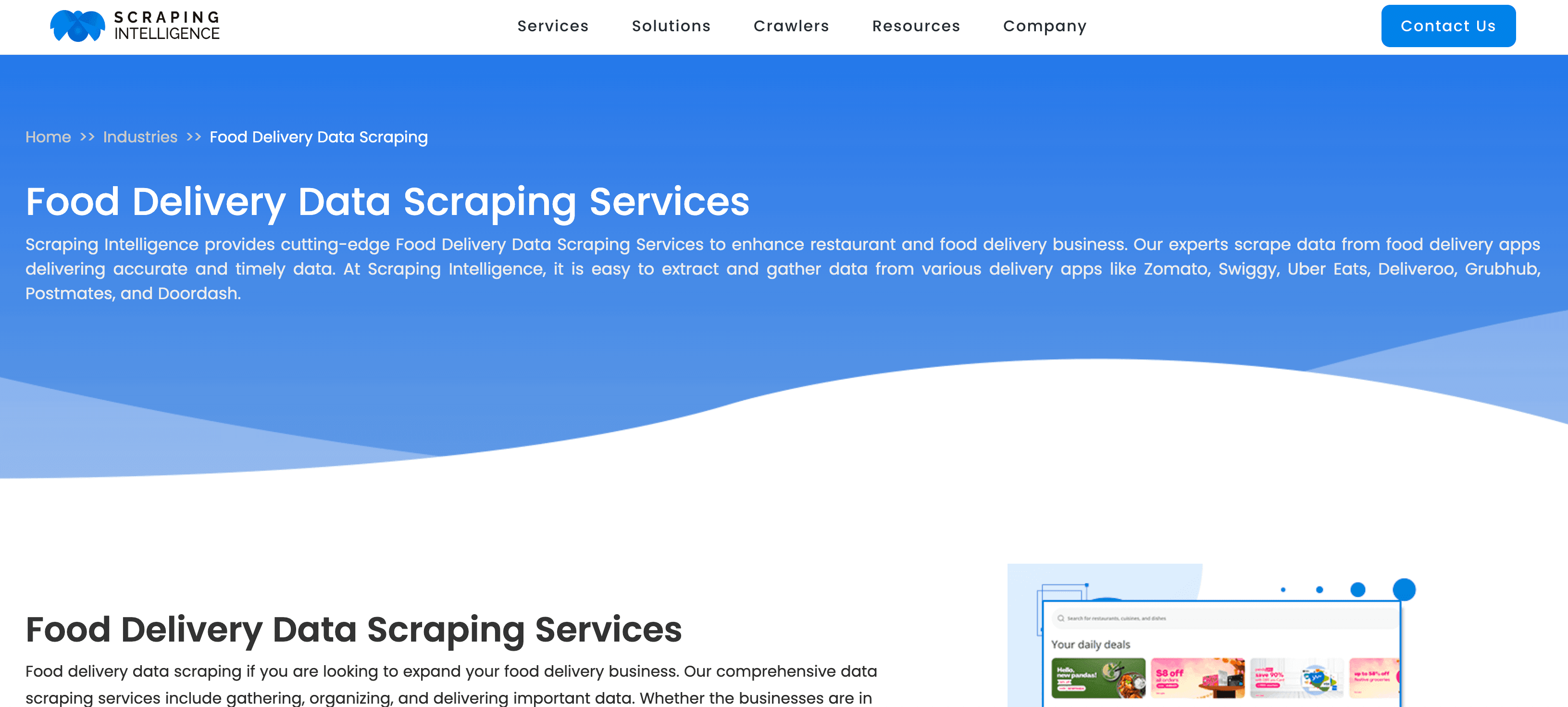
Websitescraper (aka Scraping Intelligence) offers both custom scraping services and a Food Delivery Scraping API.
- All Major Platforms: Zomato, Swiggy, Uber Eats, Grubhub, DoorDash, and more.
- Easy Integration: API or downloadable datasets.
- User-Friendly: Managed service with a focus on reliability and customization.
Best for: Businesses that want plug-and-play data extraction without technical overhead.
iWeb Data: Food Data Scraping for Global Delivery Platforms
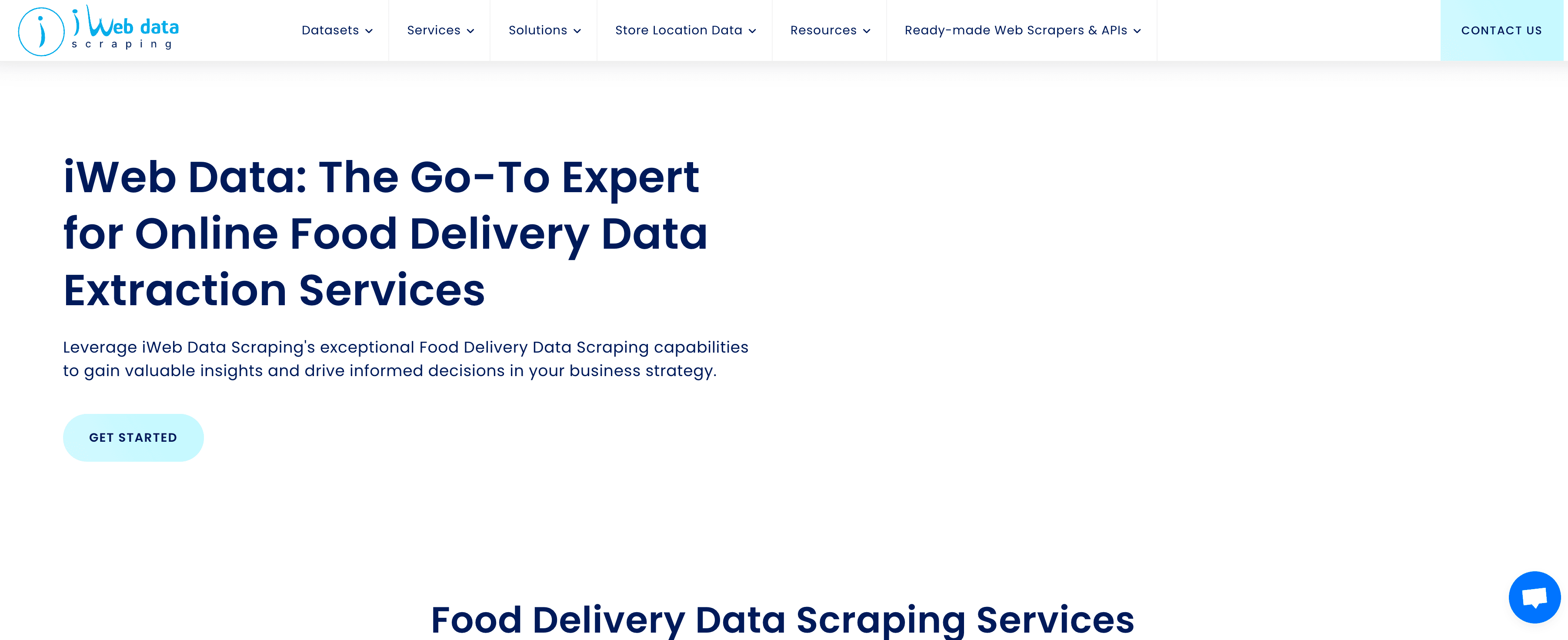
iWeb Data stands out for its global reach and flexible delivery.
- Worldwide Coverage: Uber Eats, Grubhub, Deliveroo, FoodPanda, and more, across 15+ countries.
- Custom Delivery: Email, API, webhooks, FTP, direct database import—you name it.
- Fast Support: Quick turnaround and maintenance when sites change.
Best for: Companies operating in multiple regions or needing data in specific formats.
Botster: No-Code Food Data Scraping Bots
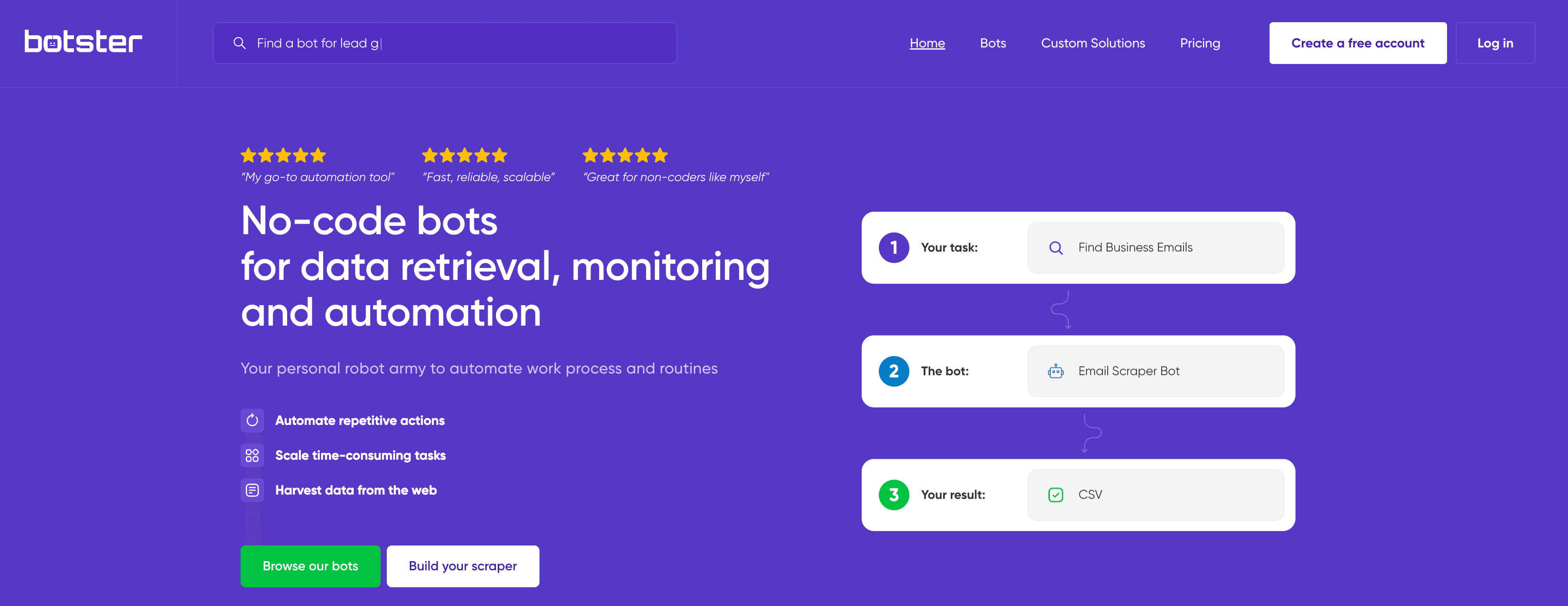
Botster democratizes scraping with its no-code bot builder.
- Point-and-Click: Build custom scraping bots without writing code.
- Templates & Scheduling: 100+ ready-made bots and the ability to run scrapes on a schedule.
- Flexible Exports: Excel, CSV, email, Slack, Google Drive, and more.
Best for: Non-technical users or small teams who want to DIY their data scraping.
WebData Crawler: Quick Commerce and e-Food Data Extraction
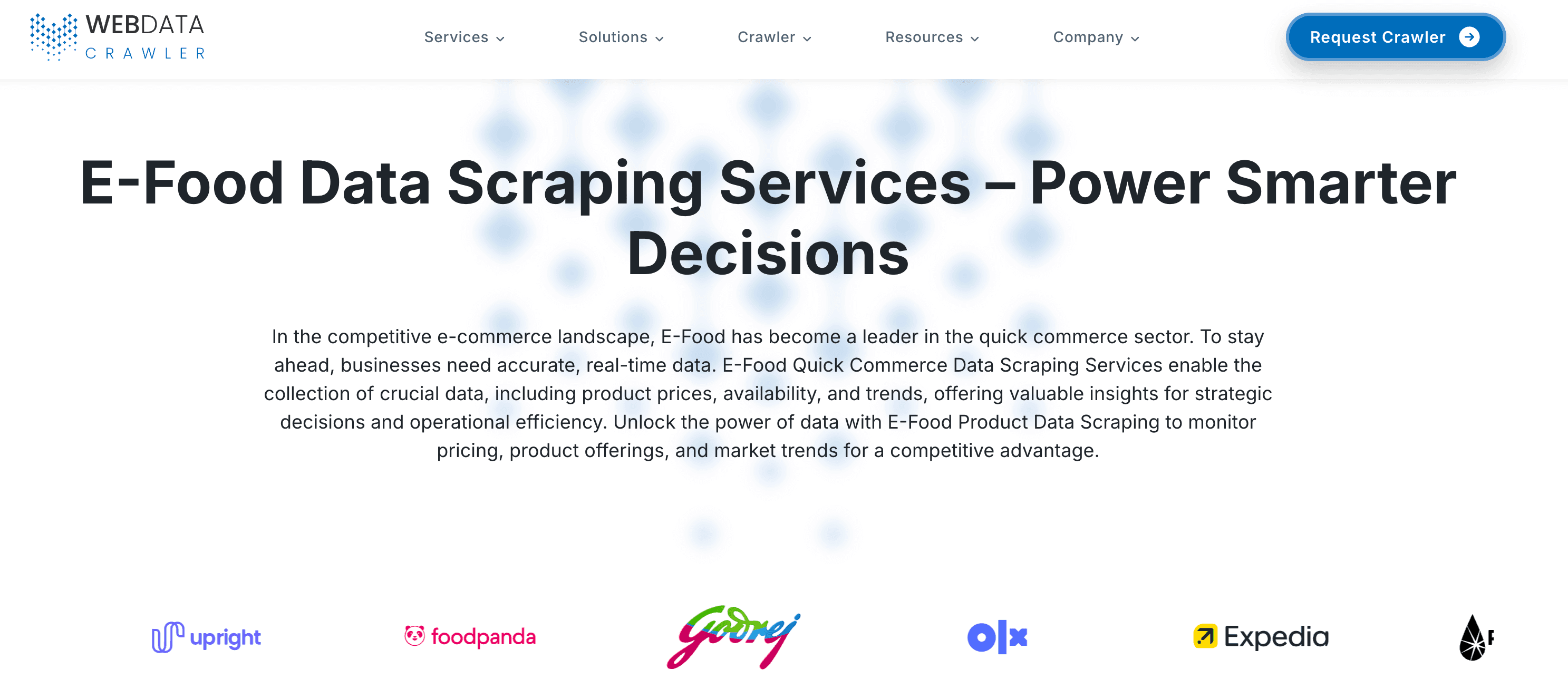
WebData Crawler specializes in real-time, scalable scraping for food and quick commerce platforms.
- Speed & Scale: Designed for rapid, large-scale data extraction (think: Instacart, Gopuff, Blinkit).
- Real-Time Insights: Stay on top of inventory, pricing, and trends as they happen.
- Enterprise Focus: Integration with dashboards and APIs.
Best for: Quick commerce companies, CPG brands, or anyone who needs up-to-the-minute data at scale.
Key Takeaways: Choosing the Best Food Data Scraping Service for Your Needs
So, which food data scraping service should you pick? Here’s my cheat sheet:
- For instant, no-code scraping: Thunderbit or Botster.
- For enterprise-scale, custom datasets: , Foodspark, or Actowiz.
- For analytics and insights: Xwiz or Actowiz.
- For developer integration: RealdataAPI.
- For global reach: iWeb Data or Foodspark.
- For quick commerce: WebData Crawler.
Remember, the best tool is the one that fits your workflow, technical skill, and budget. My advice? Start with a free trial or pilot project—Thunderbit’s free tier is a great way to see what’s possible in just a couple of clicks (). You can always scale up to a managed service or API as your needs grow.
If you’re curious about how to scrape other types of data (like articles, PDFs, or even social media), check out more guides on the . And if you have questions, reach out—I’m always happy to talk shop about food, data, or why pineapple on pizza is a debate that will never end.
FAQs
1. What is food data scraping, and why is it important in 2025?
Food data scraping involves extracting structured data from food delivery apps and restaurant websites—such as menus, prices, reviews, and delivery times. In 2025, it's essential for staying competitive in a fast-moving $840+ billion market, enabling better pricing strategies, menu planning, customer insight, and operational efficiency.
2. What types of data can be scraped from food delivery platforms?
Top food scraping services can collect a wide range of data, including restaurant names, menus, prices, promotions, customer ratings, delivery fees, estimated delivery times, nutritional info, and even images. This helps businesses with pricing, market research, sentiment analysis, and trend tracking.
3. How do I choose the right food data scraping service for my business?
You should consider factors like supported platforms (e.g., Uber Eats, DoorDash), ease of use (no-code vs. developer-focused), AI features, data accuracy, export options, compliance, and scalability. Tools like Thunderbit are great for no-code users, while APIs like RealdataAPI cater to developer teams.
4. What makes Thunderbit stand out among food scraping tools?
Thunderbit offers a Chrome extension with AI-suggested fields, subpage scraping, pagination handling, and one-click export to Google Sheets or Excel. It requires no coding and is ideal for fast, user-friendly scraping—even offering scheduled runs and a free tier to get started.
5. Can these services handle large-scale or enterprise-level scraping needs?
Yes. Services like , Actowiz, and Foodspark specialize in enterprise-level data scraping with custom datasets, scheduling, AI-driven data cleaning, and API access. They're best suited for large restaurant chains, aggregators, or market intelligence teams needing reliable, scalable solutions.
Related Reading: